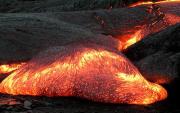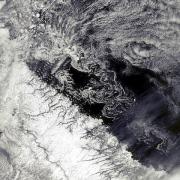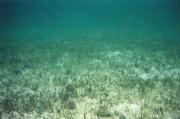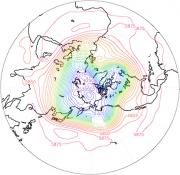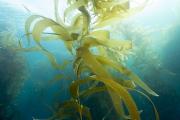Radio Program
Our regular Science and the SeaTM radio program presents marine science topics in an engaging two-minute story format. Our script writers gather ideas for the radio program from the University of Texas Marine Science Institute's researchers and from our very popular college class, Introduction to Oceanography, which we teach to hundreds of non-science majors at The University of Texas at Austin every year. Our radio programs are distributed at to commercial and public radio stations across the country.
When a volcano began erupting on the island of Hawaii in May of 2018, satellites kept a close eye on it. Just three days after the lava flow hit the ocean, for example, they saw that the water was turning green. And it stayed green until after the eruption ended a few months later.
The Kilauea volcano belched millions of cubic feet of rock. The flow destroyed about 700 houses and covered more than 10 square miles on the island’s eastern tip.
Hundreds of submarines glide through the world’s oceans. Most of them are military, but some sail for science. They measure temperatures and currents, sample the water, map the sea floor, and perform other tasks -- revealing the secrets of the oceans.
There’s an old saying that if life gives you lemons, make lemonade. Some folks in northeastern Canada are following that advice -- with a twist. When life gives them icebergs, they’re making vodka -- and selling excursions to the bergs to eager tourists.
The businesses are taking off along “iceberg alley.” That’s a stretch of ocean from Greenland to Labrador and Newfoundland. Big chunks of ice break off glaciers in Greenland and follow the current down to Canada.
Biologists have been sampling life in the Gulf of Mexico for decades. Yet they're a long way from getting acquainted with everything that lives there.
Consider a tiny shark that was discovered there a decade ago. When researchers pulled it from the water, they didn't recognize it. It took them until 2019 to classify it. It turns out the shark is a member of a species never seen before.
A massive tsunami in northwestern Sumatra wiped out coastal villages for miles. Only one survived. But by a century later, its influence began to wane -- the result of a new power settling on the sites of the destroyed villages.
Archaeologists began studying the area in detail after another tsunami, in 2004, killed more than 150,000 in Sumatra alone. And in 2006, one researcher discovered bits of pottery and Muslim gravestones that were uncovered by the 2004 tsunami. He recruited a large team to study a 25-mile stretch of coastline in a region known as Aceh.
For the flashlight fish, school doesn't end at night. In fact, the schooling is just getting started. The fish is one of the few known to congregate in schools at night, even when there's no moonlight. That's because the flashlight fish brings its own lights, so all the members of the group can keep an eye on each other.
The flashlight fish is found at depths of up to a few hundred feet in the tropical Atlantic, Pacific, and Indian oceans. It has a patch below each eye that emits blue light. It's one of the few species of light-producing fish that doesn't live in the deep ocean.
When Hurricane Harvey hit Texas in 2017, it killed almost 70 people and inflicted more than a hundred billion dollars’ worth of damage.
Not all of the damage was visible, though. Some of it was on the bottom of the lagoons along the coast. Harvey ripped up seagrass beds, which provide shelter and breeding grounds for many species of fish and shellfish, and hunting grounds for birds and other critters. That could change the complexion of those regions for years.
With a top speed of a few hundred feet per hour, the giant tortoise won’t win many races. Compared to some of the longest waves in the oceans, though, it’s like an Indy race car. The waves are almost entirely below the surface. And they can take a decade or longer to ripple from one side of an ocean to the other. Until recently, that made them almost impossible to see.
Earth's changing climate is expected to produce higher temperatures and stronger tropical storms. And when you put those two together, the results could be especially deadly.
A team of scientists recently studied the risks of extreme heat -- defined as a heat index of 105 degrees Fahrenheit or higher -- after the landfall of a hurricane or typhoon. The team found that such a one-two punch could pose major health risks for millions of people.

